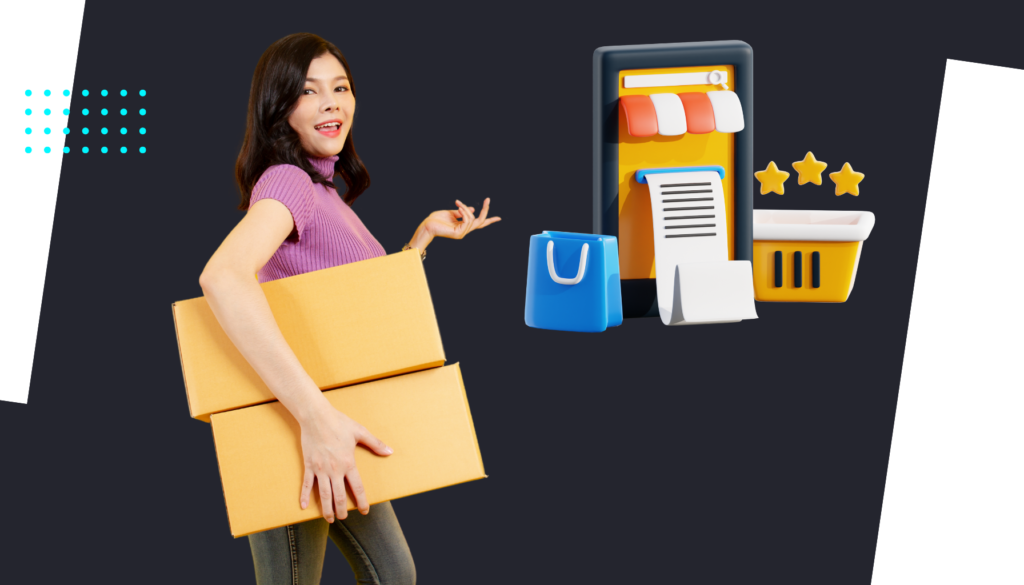
Optimizing your e-commerce conversion rate sounds like a dream come true.
Picture this: without having to increase your traffic acquisition efforts, you are generating more sales, hence more revenue.
The issue here is, how?
Simply changing your colors, rearranging your products, and implementing intrusive pop-ups is not going to do much for you. Actually, it can harm more than help, as these changes can easily annoy visitors and deter them from completing a purchase.
No, my marketer friend, to truly boost your e-commerce conversion rates through conversion rate optimization, you need a strategic, data-driven approach that enhances the shopping experience and gently nudges customers towards making a purchase.
Table of Contents
What is E-Commerce Conversion Rate Optimization?
E-commerce conversion rate optimization or e-commerce CRO is the process of enhancing the online shopping experience to increase the percentage of visitors who complete a desired action on an e-commerce platform.
This desired action can range from making a purchase in most B2C e-commerce stores to signing up for a product free trial in some B2B industrial e-commerces, or any other goal relevant to the business.
How to Calculate Your E-Commerce Conversion Rate
Since you are trying to optimize a rate -and not an absolute amount- first you need to calculating your traffic-to-purchase ratio.
You’ll need:
- Total number of conversions: This is the total count of the specific action (like sales) that you’ve defined as a conversion over a given period.
- Total number of visitors: This is the total number of unique visitors to your site over the same period.
The formula to calculate the e-commerce conversion rate is:

For example, if your e-commerce site had 15,000 unique visitors last month and made 300 sales that would mean that for every 100 visitors to your site, 2 of them made a purchase, so your e-commerce conversion rate would be 2%.
What is the Typical E-Commerce Conversion Rate By Industry?
E-commerce conversion rates can vary widely depending on the industry, product types, market conditions, and the quality of the website experience.
From our experience, here are typical conversion rates by some common e-commerce industries, reflecting averages that can help benchmark your own site’s performance:
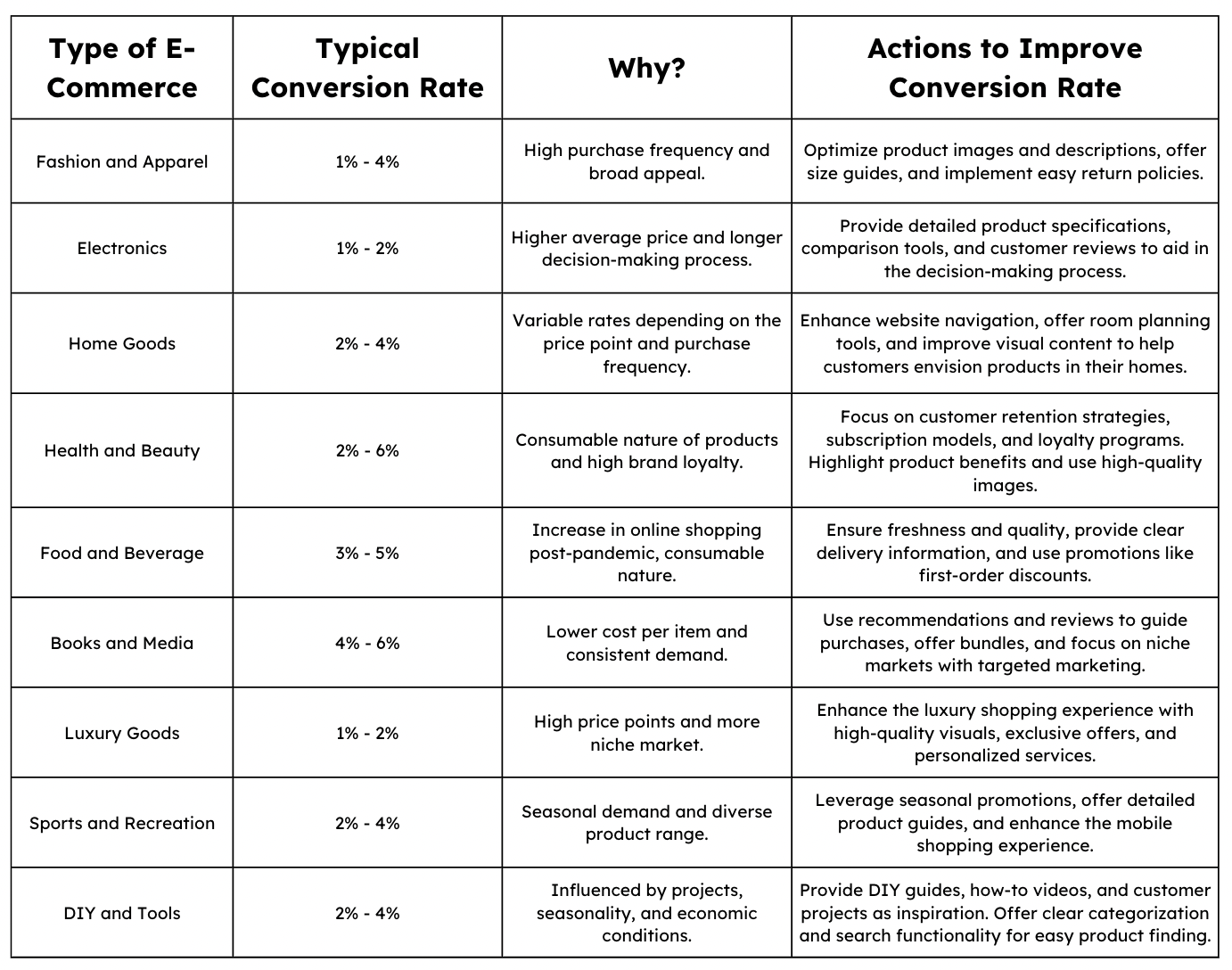
Why Is My E-Commerce Conversion Rate So Low?
If only we got a cent for every time we hear that question.
First, remember the percentages provided in the table above are industry averages and there could be countless factors affecting your conversion rate.
But, if you are finding that your e-commerce conversion rate is lower than industry standards or has dropped recently, you have to start identifying and addressing these issues.
These are some of the things you have to check:
1. Poor User Experience (UX)
A complicated navigation, confusing website layout, or a slow-loading site can significantly impact your conversion rates. Users expect a smooth, intuitive shopping experience.
⭐ How to improve it?
- Understand your visitors’ customer journey with Pathmonk Intelligence, including key touchpoints and frictions that influence the decision-making process
- Optimize your website’s loading time.
- Ensure your website’s design is intuitive and easy to navigate.
- Make sure your site is mobile-friendly.
2. Lack of trust signals
Trust is crucial in e-commerce. If customers don’t feel secure, they won’t complete a purchase. Lack of trust can stem from missing security features, limited payment options, or insufficient product information.
⭐ How to improve it?
- Display customer testimonials, ratings, and reviews when your visitors are losing trust with Pathmonk Accelerate
- Offer multiple, well-known payment options.
3. Inadequate product descriptions or poor-quality images
Customers rely heavily on product descriptions and images when making online purchases. Poor-quality images or inadequate information can deter purchases.
⭐ How to improve it?
- Use high-resolution images from multiple angles.
- Provide detailed, accurate product descriptions.
4. Complicated checkout process
A long or confusing checkout process is one of the top reasons for cart abandonment. Requiring too many steps or too much information can drive customers away.
⭐ How to improve it?
- Simplify the checkout process to a few clear steps.
- Offer guest checkout options.
- Clearly display all costs (including shipping) upfront.
5. Weak Call to Action (CTA)
If your CTAs are not compelling or are difficult to find, customers may not proceed with their purchases.
⭐ How to improve it?
- Use strong, action-oriented CTA text.
- Ensure CTAs they are displayed strategically when your visitors are ready to take action with Pathmonk Accelerate.
6. Ineffective traffic acquisition and retargeting
Sometimes the issue isn’t with the site itself but how you’re driving traffic to it. Poorly targeted ads or insufficient retargeting efforts can lead to low conversion rates.
⭐ How to improve it?
- Refine your advertising strategy to target your ideal customer demographics.
- Implement retargeting campaigns to bring back visitors who didn’t convert.
7. Lack of engagement
Engagement can be a key driver of conversions. If your e-commerce visitors are not engaged, they are less likely to feel committed and make a purchase. And no, adding a generic “spin-a-discount wheel” doesn’t do the trick.
⭐ How to improve it?
- Personalize your visitors interactions with Pathmonk Accelerate’s AI-powered microexperiences
- Offer promotions or incentives.
- Off-site, make sure to engage with customers on social media and via email newsletters.
8. High competition
In markets with intense competition, customers might be comparing multiple options. So, while it’s not something that you can fix on page, if competitors offer better prices, services, or products, it can affect your conversion rate.
⭐ How to improve it?
- Use our free template to conduct a thorough competitive analysis to understand your market position.
- Differentiate your offering with unique selling propositions. Consider your pricing strategy, enhance value through additional services such as faster shipping or longer warranty options, and leverage every bit of market intelligence in your favor.
How to Use AI for Improving E-Commerce Conversion Rates
Using Artificial Intelligence in e-commerce is a game-changer for improving conversion rates.
The potential of AI for analyzing large volumes of data quickly and accurately, providing insights and automated actions are way beyond human capabilities, which is why we have created Pathmonk Accelerate for e-commerces.
Unlike more traditional tools, Pathmonk Accelerate uses AI to personalize the shopping experience for each visitor based on their browsing patterns and previous interactions. This level of customization improves engagement and conversion rates.
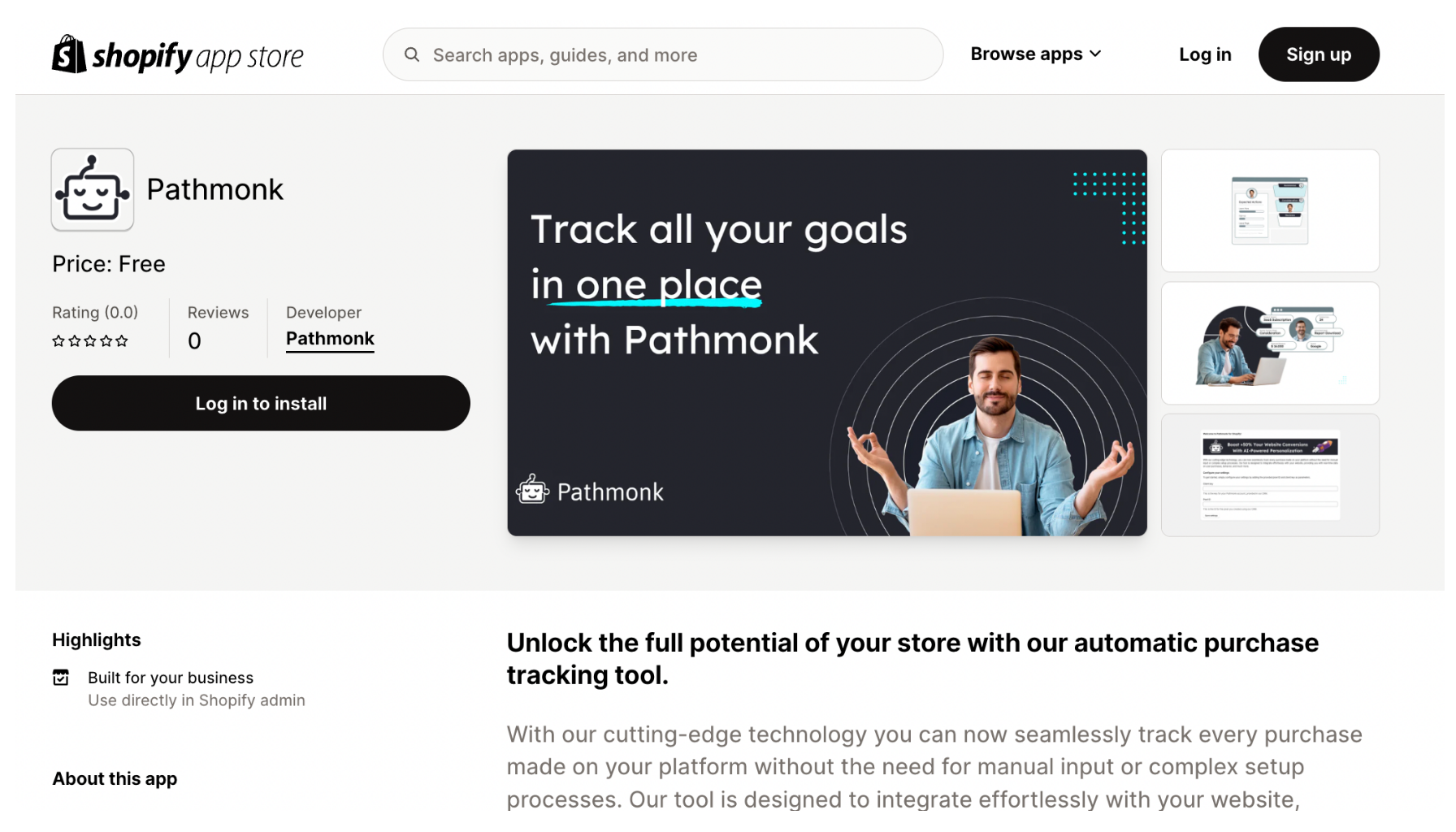
Integration with Pathmonk Accelerate is straightforward, minimizing technical challenges as it easily connects with a wide range of e-commerce platforms, such as Shopify, Prestashop, or Magento, and website builders. It also automates many tasks associated with conversion rate optimization, such as A/B testing, user engagement analysis, and performance tracking, which frees up resources to focus on other areas of business development.
Success Stories: How Iron Neck Has Escaled Sales With Pathmonk Accelerate
Founded in 2012 by former UCLA football player Mike Jolly, Iron Neck was inspired by a serious concern: the devastating effects of head injuries and Chronic Traumatic Encephalopathy (CTE) witnessed among athletes. Motivated by the plight of his former teammates and breakthrough research indicating a link between neck strength and reduced concussion risk, Jolly developed the Iron Neck, an isometric and rotational neck strengthener designed to mitigate these risks.
Facing the Digital Challenge: Traffic That Doesn’t Convert
Like many online businesses, Iron Neck confronted a fundamental issue: optimizing their website to convert visits into sales. The challenge was multifaceted, not just about driving traffic, but ensuring that once visitors arrived, they encountered a seamless, informative, and engaging experience that would persuade them to purchase.
Marketing Manager Sam Kuhn recognized that the typical Iron Neck customer preferred to independently research and shop online. The objective was clear: transform the Iron Neck website into a resource-rich platform where shoppers felt informed and confident about their purchasing decisions.
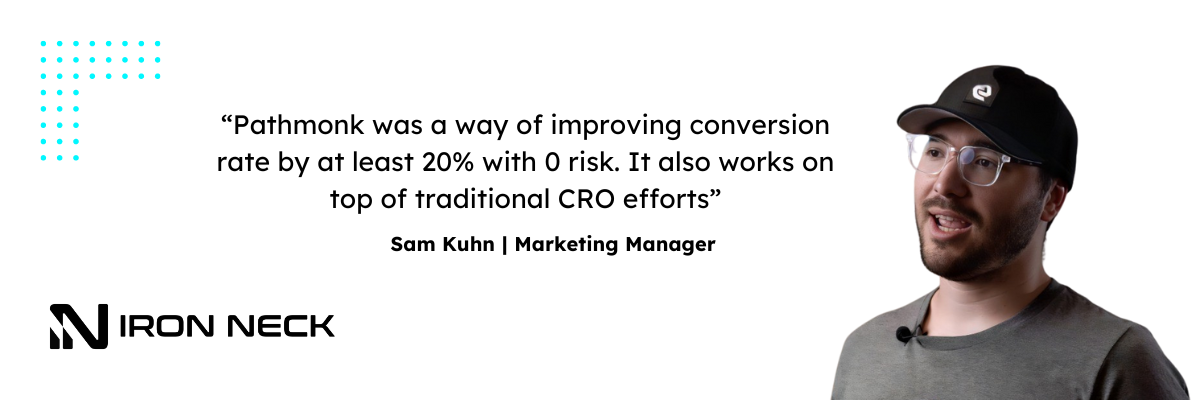
Innovative Engagement for Personalized Shopping
To overcome these challenges and increase online sales, Iron Neck partnered with Pathmonk to implement our AI-powered personalization engine. This strategic move was aimed at enhancing the engagement and effectiveness of the website by guiding visitors through a personalized buying journey.
Strategic implementations included:
- Introduction videos: At the awareness phase, visitors were immediately welcomed with concise videos that clearly articulated the value propositions of Iron Neck. This strategy was crucial for capturing attention and encouraging further exploration of the site.
- Customer reviews and testimonials: During the consideration phase, the website showcased testimonials from satisfied customers. This not only built trust but also leveraged social proof to reassure potential buyers of the effectiveness and quality of Iron Neck products.
- Simplified product selection quiz: Recognizing the potential overwhelm in choosing the right product, Iron Neck introduced an intuitive quiz that asked visitors a few simple questions about their needs and preferences. The quiz then suggested the most suitable Iron Neck product, simplifying the decision-making process and personalizing the user experience.
Measurable Success: +26% Sales in Just One Month
The collaboration with Pathmonk yielded significant results:
✅ 26% increase in sales: The personalized shopping experiences contributed to a remarkable lift in purchases from the website within just four weeks.
✅ Better product match: The introduction of a short questionnaire helped guide customers to the product that best suited their needs, improving customer satisfaction.
✅ Enhanced user experience: The site’s navigation was streamlined, making it easier for visitors to explore and purchase, thereby improving overall customer satisfaction.
✅ Increased credibility: Showcasing customer reviews prominently helped build trust and confidence in the brand.
Increase e-commerce sales with personalized experiences
Turn your e-commerce visitors into loyal customers with AI-powered personalization.
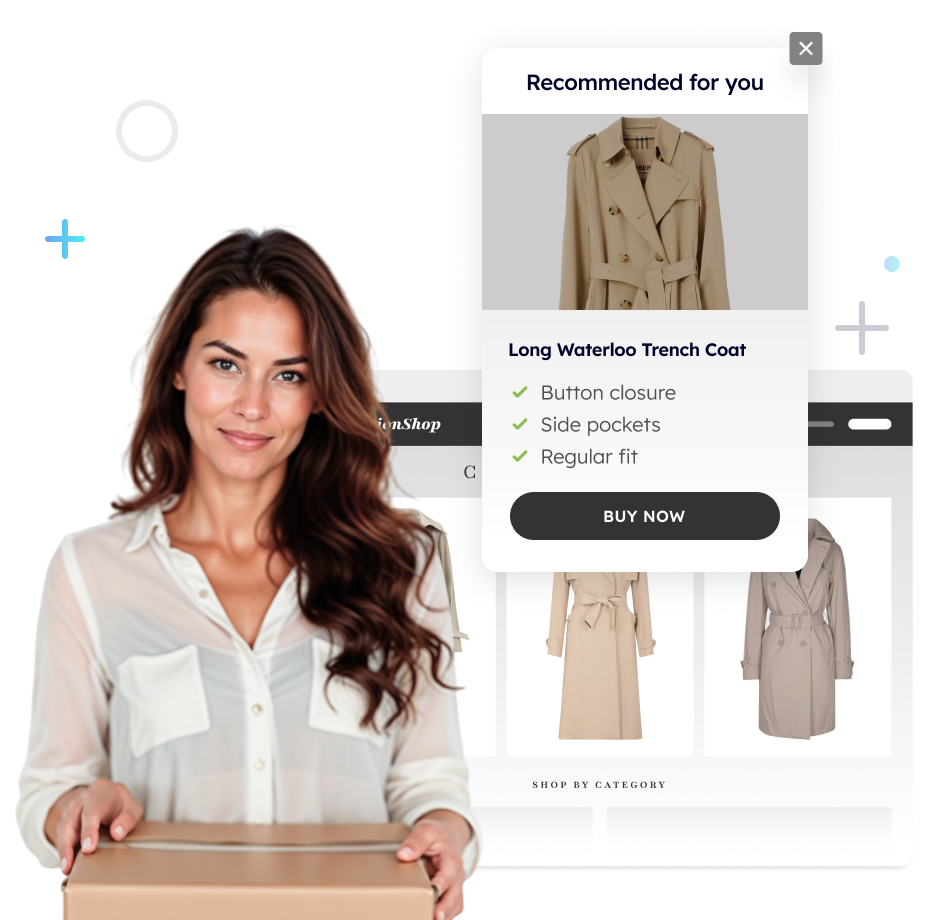
🔗 Discover all our partners and integrations





